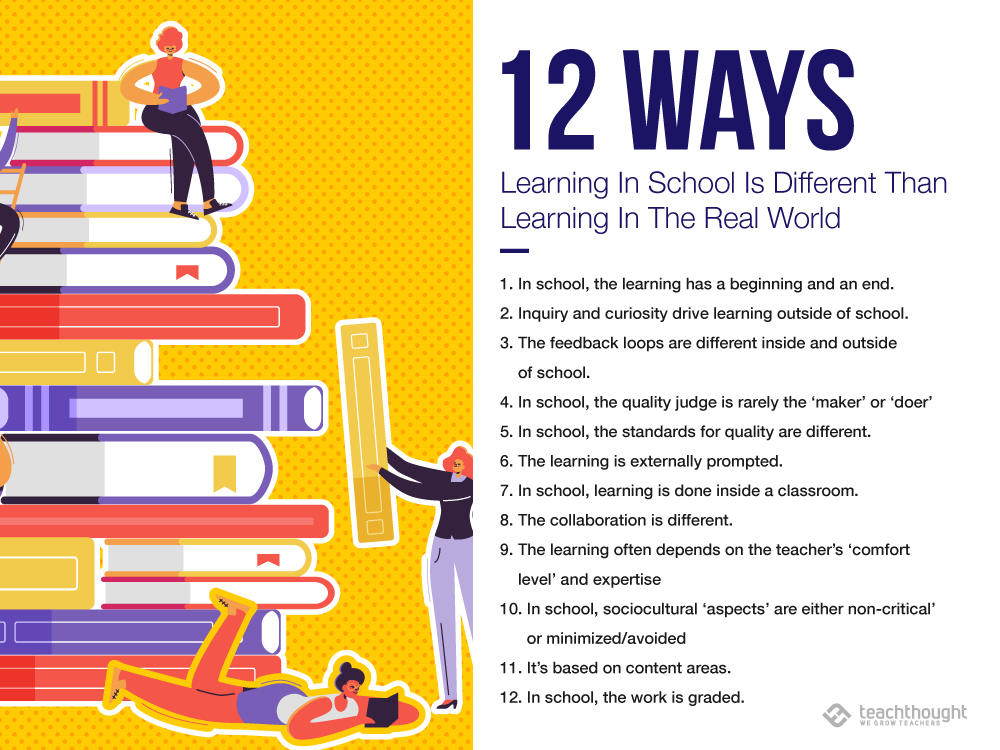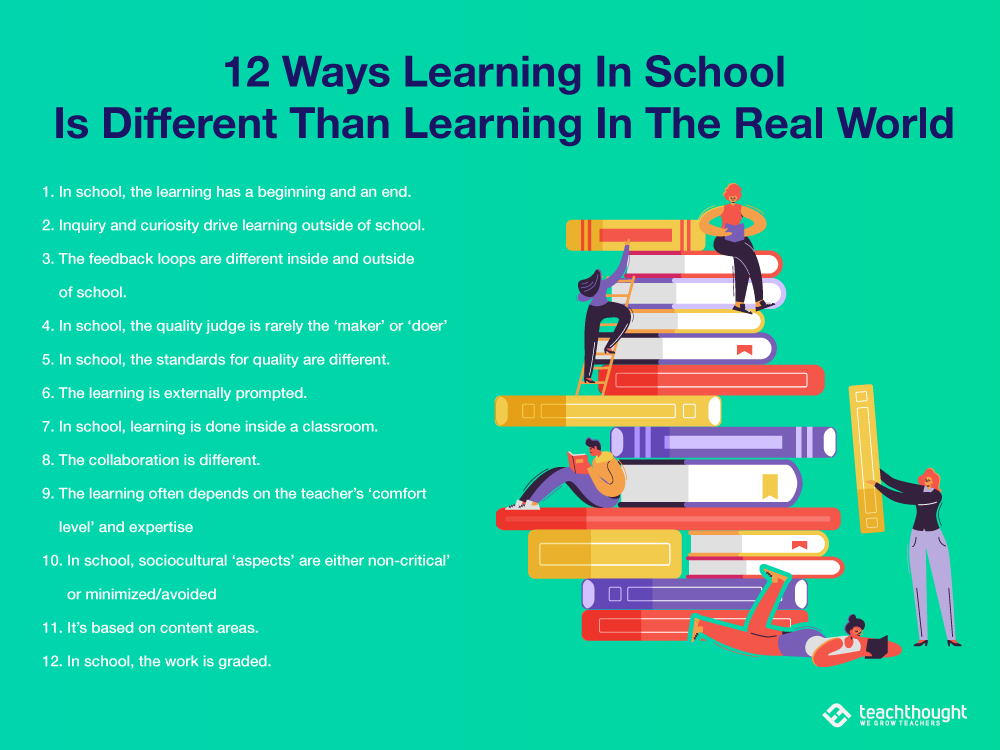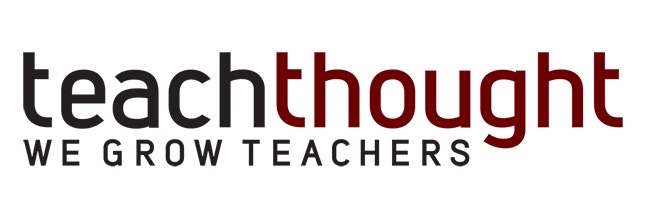
课堂上的学习与在现实世界中的学习有何不同
经过特里·希克(Terry Heick)
Quick post with a basic premise: how are ‘school learning’ and ‘real world learning’ different?
就目前而言,我们将跳过有关这是否不好,如何最小化,为什么是这种情况等的更关键的讨论。其中许多是在书籍和TED演讲和社交媒体上进行的。就目前而言,只需快速逐步逐步逐步逐步逐步逐步逐步逐步逐步逐步逐步逐步逐步逐步逐步逐步逐步逐步学习。
Some of this is due to the nature of outcomes-based learning. In50 Ways To Measure Understanding,在讨论“衡量”理解的想法时,我说:
逐项列出衡量理解的方法在功能上与学生选择一种证明自己所知道的方式的方法不同,因为在向后设计的方法中,首先确定学习目标的方法,学习目标决定了下游的其他一切。
If, for example, a student was given a topic and an audience and was allowed to ‘do’ something and then asked to create something that demonstrated what they learned, the result would be wildly different across students. Put another way, students would learn different things in different ways.
通过准确决定每个学生将提前“理解”的内容,某些评估表成为理想。学生也更有可能失败。如果学生能够学习任何东西,那么只有在根本无法学习或根本无法展示任何东西的情况下,他们才会失败。通过确切地确定学生将学到什么以及他们将如何向您展示他们学到的知识,还有三个结果,包括:
1. The student learned a lot but not what you wanted them to learn
2. The student learned exactly what you wanted them to learn but failed to demonstrate it in the assessment
3.学生未能学习
Note, not all of these are always true. There are exceptions–sometimes mesmerizing ones with elegant solutions to modern challenges of formal, K-12 education. The idea here is to simply become more aware of the kinds of shifts students must make whentransferring learning从课堂到他们的生活的技能和理解。

在学校学习的12种方式与现实世界中的学习不同
1.在学校,学习有一个开始和结束。
因为上学的日子开始和结束,课程,单位和学历也是如此,所以在学校学习的任何学习也必须这样做。学校的学习是根据学校时间表,课程和单元设计等短暂进行的。
2.询问和好奇心推动了学校外的学习。
学校学习可以从中受益好奇心和询问,但在几乎每种情况下,都可能会毫无生气地分级 - 没有它。在现实世界中,好奇心,询问和紧张的反馈循环推动学习。
3。反馈循环在学校内外不同。
也就是说,时间,即时性,持续时间和来源(因此)反馈回路are different in a classroom than they are in the real world.
4.在学校里,质量法官很少是“制造商”或“行动者”
Or their peers or an authentic audience or ‘client’ but rather the external and singular (e.g., the teacher, a computer algorithm, etc.) This ‘quality judge’ is usually a person (i.e., teacher) and singular and often not an ‘expert’ or able to give the time and care and affection a topic or skill or project deserves due to extraordinary time demands made on them elsewhere
5.在学校,质量标准是不同的。
在学校里,工作质量标准的来源通常是外部的,几乎总是“单数”(来自一个人)。除其他效果外,这决定了学习反馈的深度,数量,时机和“框架”。
6.学习是在外部提示的。
并由上述“质量法官”这样做。这意味着它很少基于好奇心,天才或预期的应用。
7.在学校里,学习是在教室内完成的。
除非是混合学习的类型或基于项目的学习以某种方式完成/放置在“现实世界”中,学校学习是在学校完成的。
即使不是,学习的“围墙花园”是以制度为中心的,并以标准为中心的,而不是基于好奇心,买卖,创造力或其他一些“更真实的”背景。
8.合作是不同的。
In school, the people, timing, purpose, and nature of any collaboration are different than the real world. Among other results, this means that collaboration that does result is rarely authentic or ‘以学生为中心。’
9.学习通常取决于老师的“舒适水平”和专业知识
This one isn’t the teacher’s fault–it’s just inherent to an outcomes-based, teacher-led classroom. It’s not only difficult for a teacher to teach something they don’t know or aren’t comfortable with, but it can also reduce student learning or even be dangerous (e.g., privacy concerns in social media, for example).
10. In school, sociocultural ‘aspects’ are either non-critical’ or minimized/avoided
在课堂上,文化通常被“添加到”中。在现实世界中,文化通常是学习和学习过程的基础或重点。性别,种族,贫穷,性,政治,舞蹈,艺术等很少是在现实世界中学习的动力,显然是。
11. It’s based on content areas.
尽管在现实世界中学习有时可以基于“数学”和“语言艺术”,但更常见的是,这些内容领域只是为了提供和改善学习过程本身的来源。例如,如果有人想学习建造围栏,他们可能会学会计算区域和周边以实现这一目标。
In school, those content areas are ‘mastered’ in hopes that one day students might need to use that skill or apply that knowledge.
12.在学校里,工作得分。
这些成绩 - 比起工作,流程以及产品和网络在进行分级工作时创建的产品和网络都可以“坚持”学生。
在学校学习的12种方式与现实世界中的学习不同
